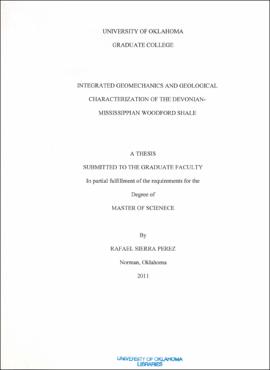| dc.contributor.author | Sierra Perez, Rafael | |
| dc.coverage.spatial | Woodford Shale (Okla. and Texas) | |
| dc.date.accessioned | 2022-12-19T18:00:16Z | |
| dc.date.available | 2022-12-19T18:00:16Z | |
| dc.date.created | 2011 | |
| dc.date.issued | 2011 | |
| dc.identifier.uri | https://hdl.handle.net/11244/336966 | |
| dc.description | Thesis (M.S.)--University of Oklahoma, 2011. | |
| dc.description | Includes bibliographical references (leaves 91-101). | |
| dc.description.abstract | In this thesis, preserved Woodford Shale samples of different mineralogy compositions were obtained from a shallow research well in Oklahoma and prepared for various laboratory mechanical characterizations including the Ultrasonic Pulse
Velocity (UPV) measurements, the unconfined compressive test, and the Inclined Direct Shear Testing Device (IDSTD™). In addition, the Woodford Shale fracture propertie, including anisotropic tensile strength and fracture toughness, were investigated through a suite of Brazilian Tensile and Chevron tJotched Semicircular Bend (CNSCB) tests with acoustic emission (AE) recorded during testing. The geomechanics characteristics of the Woodford Shale were modeled with correlation to mineralogy and micro-fabric on its effects on the mechanical properties were also studied with results from thin sections and XRD analysis performed on tested samples. The UPV and Brazilian test results show a clear anisotropic nature of Woodford Shale poroelastic properties and tensile strength. Investigations on the effects of shale mineralogy and morphology on its anisotropic mechanical properties show correlation between the degrees of anisotropy with clay packing density variation. Despite the limited number of tests reported, an increasing trend of Woodford Shale tensile strength with carbonate content could be observed. This proportional increase of tensile strength with carbonate content may suggest the strength-increasing nature of carbonate minerals in the Woodford Shale. CNS CB test results showed that the fracture toughness of the quartz-rich Upper Woodford samples is significantly higher (up to 57%) than the fracture toughness of samples from the more clay-rich Middle and Lower Woodford. This will lead to a lot of variability in hydraulic fracture planning and design. Also, the acoustic emissions prior to the fracture propagation in CNSCB tests could only be observed for the lower clay samples belonging to the Upper Woodford. Furthermore, the integration of these results with the previously defined sequence stratigraphic framework resulted in the definitions of brittle and ductile couplets at the parasequence scale, which might be valuable for well placement and completion designs. | |
| dc.format.extent | xiii, 110 leaves | |
| dc.format.medium | xiii, 110 leaves : ill. (some col.), col. maps ; 29 cm. | |
| dc.language.iso | eng | |
| dc.subject.lcsh | Woodford Shale (Okla. and Texas)--Testing | |
| dc.subject.lcsh | Shale--Testing | |
| dc.title | Integrated geomechanics and geological characterization of the Devonian-Mississippian Woodford Shale | |
| dc.type | Text | |
| dc.contributor.committeeMember | Akkutlu, Yucel | |
| dc.contributor.committeeMember | Keranen, Katie | |
| dc.contributor.committeeMember | Slatt, Roger M. | |
| dc.contributor.committeeMember | Abousleiman, Younane N. | |
| ou.group | Conocophillips School of Geology and Geophysics | |
